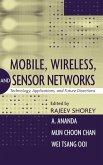Since the first edition of this book published in 1995, the world has rapidly moved away from nearly exclusive reliance on wired networks to today?s era of "tetherless" communications based almost exclusively on wireless technology. Today wireless information networks are the most important technology in telecommunications with innumerable applications besides cellular telephony, such as data networks, grid computing, WiFi and many others. Wireless Information Networks, 2nd Edition is fully updated to reflect the current state of the technology and discusses future developments. The book is reorganized into four parts: I: Introduction to wireless networks, including the evolution of cellular industry from analog cellular to 2G, 3G and 4G; the emergence of WLAN and WPAG as broadband ad hoc networks; II: Characteristics of Radio Channel propagation, with the addition of channel modeling for Space-Time, MIMO and UWB; III: Radio modems, added description for Space-Time, MIMO and UWB; and IV: Special topics.
Towards location aware mobile ad hoc sensors
A Systems Engineering Approach to Wireless Information Networks
The Second Edition of this internationally respected textbook brings readers fully up to date with the myriad of developments in wireless communications. When first published in 1995, wireless communications was synonymous with cellular telephones. Now wireless information networks are the most important technology in all branches of telecommunications. Readers can learn about the latest applications in such areas as ad hoc sensor networks, home networking, and wireless positioning.
Wireless Information Networks takes a systems engineering approach: technical topics are presented in the context of how they fit into the ongoing development of new systems and services, as well as the recent developments in national and international spectrum allocations and standards. The authors have organized the myriad of current and emerging wireless technologies into logical categories:
_ Introduction to Wireless Networks presents an up-to-the-moment discussion of the evolution of the cellular industry from analog cellular technology to 2G, 3G, and 4G, as well as the emergence of WLAN and WPAN as broadband ad hoc networks
_ Characteristics of Radio Propagation includes new coverage of channel modeling for space-time, MIMO, and UWB communications and wireless geolocation networks
_ Modem Design offers new descriptions of space-time coding, MIMO antenna systems, UWB communications, and multi-user detection and interference cancellation techniques used in CDMA networks
_ Network Access and System Aspects incorporates new chapters on UWB systems and RF geolocations, with a thorough revision of wireless access techniques and wireless systems and standards
Exercises that focus on real-world problems are provided at the end of each chapter. The mix of assignments, which includes computer projects and questionnaires in addition to traditional problem sets, helps readers focus on key issues and develop the skills they need to solve actual engineering problems. A separate Instructor's Manual is available that includes a solution book and supporting material for preparing class presentations. Extensive references are provided for those readers who would like to explore particular topics in greater depth.
With its emphasis on knowledge-building to solve problems, this is an excellent graduate-level textbook. Like the previous edition, this latest edition will also be a standard reference for the telecommunications industry.
Hinweis: Dieser Artikel kann nur an eine deutsche Lieferadresse ausgeliefert werden.
Towards location aware mobile ad hoc sensors
A Systems Engineering Approach to Wireless Information Networks
The Second Edition of this internationally respected textbook brings readers fully up to date with the myriad of developments in wireless communications. When first published in 1995, wireless communications was synonymous with cellular telephones. Now wireless information networks are the most important technology in all branches of telecommunications. Readers can learn about the latest applications in such areas as ad hoc sensor networks, home networking, and wireless positioning.
Wireless Information Networks takes a systems engineering approach: technical topics are presented in the context of how they fit into the ongoing development of new systems and services, as well as the recent developments in national and international spectrum allocations and standards. The authors have organized the myriad of current and emerging wireless technologies into logical categories:
_ Introduction to Wireless Networks presents an up-to-the-moment discussion of the evolution of the cellular industry from analog cellular technology to 2G, 3G, and 4G, as well as the emergence of WLAN and WPAN as broadband ad hoc networks
_ Characteristics of Radio Propagation includes new coverage of channel modeling for space-time, MIMO, and UWB communications and wireless geolocation networks
_ Modem Design offers new descriptions of space-time coding, MIMO antenna systems, UWB communications, and multi-user detection and interference cancellation techniques used in CDMA networks
_ Network Access and System Aspects incorporates new chapters on UWB systems and RF geolocations, with a thorough revision of wireless access techniques and wireless systems and standards
Exercises that focus on real-world problems are provided at the end of each chapter. The mix of assignments, which includes computer projects and questionnaires in addition to traditional problem sets, helps readers focus on key issues and develop the skills they need to solve actual engineering problems. A separate Instructor's Manual is available that includes a solution book and supporting material for preparing class presentations. Extensive references are provided for those readers who would like to explore particular topics in greater depth.
With its emphasis on knowledge-building to solve problems, this is an excellent graduate-level textbook. Like the previous edition, this latest edition will also be a standard reference for the telecommunications industry.
Hinweis: Dieser Artikel kann nur an eine deutsche Lieferadresse ausgeliefert werden.








